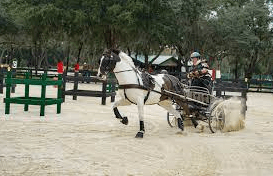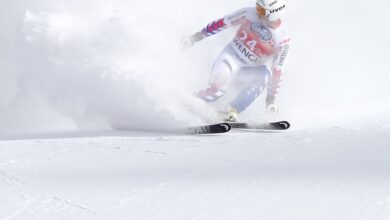What Is The Format Of A Combined Driving Event?

Combined driving events are a thrilling and challenging equestrian sport that tests the skills and abilities of both horse and driver. This unique competition consists of three distinct phases: dressage, marathon, and cones. Each phase requires precision, agility, and a deep understanding between the horse and driver.
The format of a combined driving event is designed to showcase the versatility and teamwork required in this exhilarating sport.
In the dressage phase, competitors must demonstrate their ability to execute precise movements with elegance and grace. The goal is to exhibit perfect harmony between horse and driver as they perform a series of predetermined movements within an enclosed arena. Judges evaluate factors such as accuracy, obedience, suppleness, impulsion, straightness, submission, lightness of the forehand, contact with the bit, collection, balance, self-carriage, engagement of the hindquarters, athleticism in movement quality transitions from one movement to another. This phase not only showcases the training and skill of both horse and driver but also sets the foundation for success in subsequent phases.
The marathon phase takes place on an outdoor course consisting of challenging obstacles and varied terrain. Throughout this phase competitors must navigate through gates or ‘obstacles’while maintaining speed control over long distances at faster speeds compared to other phases. The objective is to complete each obstacle within set time limits without incurring penalties for knocking down markers or deviating from designated routes. This phase truly tests the horse’s athleticism and stamina as well as the driver’s ability to make quick decisions while maintaining control under pressure.
Finally comes the cones phase where drivers must maneuver through a tight course marked by pairs of cone-shaped obstacles known as ‘gates.’Precision becomes paramount here as competitors strive for accuracy while driving at high speeds around tight turns within narrow spaces defined by these gates. Penalties are given for knocking down any gate or failing to pass through them correctly or exceeding time limits specified for completion; therefore requiring both agility from the horse and exceptional driving skill from the driver. This phase is often considered the ultimate test of accuracy, agility, and quick decision-making.
In conclusion, a combined driving event is a thrilling equestrian sport that showcases the partnership between horse and driver. With its three distinct phases – dressage, marathon, and cones – this competition challenges competitors to perform with precision, navigate challenging obstacles, and demonstrate accuracy in tight spaces. Whether you are a participant or a spectator, watching a combined driving event is sure to captivate your attention as you witness the incredible teamwork and athleticism on display.
Dressage Phase: Showcasing Precision and Elegance
The dressage phase of a combined driving event exemplifies the intricate choreography between horse and driver, showcasing their seamless coordination and grace.
This phase is often likened to a ballet on horseback, as the driver guides the horse through a series of precise movements and transitions.
Dressage techniques play a crucial role in this phase, with drivers focusing on achieving balance, suppleness, and obedience from their horses.
The importance of proper attire cannot be overstated in this discipline, as it not only adds to the overall aesthetic appeal but also serves practical purposes.
Drivers typically wear formal attire that includes a top hat or bowler hat, gloves, breeches or jodhpurs, and leather boots.
The horses are also dressed in elegant harnesses and carriage accessories that contribute to the visual harmony of the performance.
Overall, the dressage phase sets the tone for the rest of the competition by emphasizing precision and elegance while highlighting the harmonious partnership between horse and driver.
Marathon Phase: Navigating Challenging Obstacles and Terrain
Navigating challenging obstacles and terrain is a crucial aspect of the marathon phase in combined driving competitions, demanding drivers to showcase their skill and precision while maneuvering through various terrains and overcoming difficult hurdles.
The marathon phase consists of an obstacle course that includes a series of natural and man-made obstacles such as water crossings, bridges, gates, and steep hills.
Drivers must strategically plan their routes to complete the course within the allotted time while maintaining control over their horses. They need to carefully assess each obstacle before approaching it, considering factors such as speed, angle of approach, and the horse’s capabilities.
Read also: How Can One Choose A Horse For Team Penning?
It requires a deep understanding of equine behavior and training techniques to effectively navigate these challenges. The terrain can vary from open fields to dense forests, adding another layer of complexity to the task.
Overall, the marathon phase tests both the driver’s technical skills and their ability to make split-second decisions under pressure.
Cones Phase: Testing Accuracy and Agility
Cones phase in combined driving competitions challenges drivers to demonstrate exceptional accuracy and agility as they navigate through a series of precisely placed cones, invoking a sense of anticipation and excitement among spectators.
This phase requires drivers to steer their horse-drawn carriages through a course that is marked by cones positioned at strategic locations. The cones are typically color-coded, with red indicating the right side and white indicating the left side.
The objective is for the driver to maneuver their carriage around each cone without knocking it over or displacing it from its position. This requires precise control of both speed and direction, as even the slightest miscalculation can result in penalties.
Drivers must carefully plan their path through the course, making quick decisions on whether to take tight turns or wide arcs depending on the spacing between the cones. They must also be able to react swiftly to unexpected changes in terrain or obstacles that may be present within the course.
Overall, this phase tests not only the driver’s ability to accurately navigate through challenging obstacles but also their agility in making split-second decisions while maintaining control of their carriage.
Frequently Asked Questions
How are combined driving events scored?
Combined driving events are scored using various methods and judging criteria. Scoring may involve assessing performance in dressage, marathon, and obstacle driving. Judging criteria typically include accuracy, speed, technique, and overall presentation. The scoring system aims to provide an objective evaluation of participants’ performance.
Are there any specific rules or regulations regarding the use of equipment and attire in combined driving events?
Specific rules and regulations govern the use of equipment and attire in combined driving events. Participants must adhere to guidelines regarding safety, such as wearing helmets and using appropriate harnesses and vehicles for their horses.
Can spectators attend combined driving events?
Spectator restrictions may apply at combined driving events, but attending these events offers numerous benefits. Witnessing the skill and precision of competitors navigating obstacles on horse-drawn carriages provides a thrilling experience and fosters a sense of freedom and adventure.
Are there any age or experience restrictions for participating in combined driving events?
Age restrictions and experience requirements vary for participating in combined driving events. Some events may have minimum age limits, while others require competitors to have a certain level of experience or skill in driving horses.
How long does a typical combined driving event last?
How long does a typical combined driving event last? The duration of a combined driving event varies depending on the schedule, but it typically spans over multiple days, allowing participants to experience the freedom of navigating various obstacles and challenges.
Conclusion
In conclusion, a combined driving event is a thrilling and challenging competition that showcases precision, elegance, and agility. The format of the event consists of three distinct phases: dressage, marathon, and cones.
The dressage phase is all about displaying the harmony between the driver and their horse(s). It requires precise movements and impeccable control as they navigate through a series of predetermined patterns. This phase not only tests the skill and communication between the driver and horses but also highlights their ability to maintain grace under pressure.
The marathon phase takes place on a cross-country course where drivers must navigate through various obstacles such as water crossings, bridges, and tight turns. This phase emphasizes speed, endurance, and strategic decision-making as drivers aim to complete the course within a specified time frame. It is an exhilarating display of athleticism as drivers maneuver their carriages through challenging terrain with utmost precision.
Finally, in the cones phase, drivers must showcase their accuracy and agility by maneuvering through a set of carefully placed cones in a designated pattern. This phase requires quick reflexes and sharp turns as drivers aim to navigate through the course without knocking down any cones or incurring time penalties.
In summary, a combined driving event is an impressive display of skill, teamwork, and athleticism. From the elegant movements showcased during dressage to the adrenaline-fueled challenges faced in marathon and cones phases – each part captivates both participants and spectators alike.
Whether you are an enthusiast or simply intrigued by equestrian sports, witnessing these competitions unfold will undoubtedly leave you on edge – eagerly anticipating every twist and turn until its thrilling conclusion.



